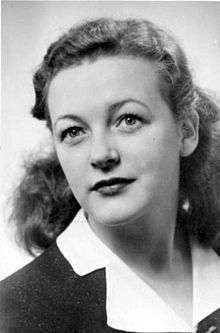Dagmar Lahlum

Dagmar Mohne Hansen Lahlum (Eidsvoll, Norway, 1922–1999) was a member of the Norwegian resistance in Oslo during World War II and was later recruited (unofficially) to work for MI5.
Early life
The daughter of a shoe maker, Lahlum had moved to Oslo when she was 17, shortly before the start of the war. Initially she worked as a receptionist in a city centre hotel and later took modeling classes.
World War II
.jpg)
In April 1943, when British double agent Eddie Chapman was drinking with German officers in The Ritz bar at Skillebekk, which also popular with members of the Norwegian national socialist party, his eye fell on the attractive Dagmar - who, complete with a décolletage and high heels - was smoking Craven A's with an ivory mouthpiece.
When he first chatted her up, he thought that she was either a prostitute or just another good time girl; whilst on the other hand Lahlum thought that he worked for the Germans, or was in fact a German - albeit one with an odd accent.
From 1943 onwards, she became his girlfriend and later his fiancée. Troubled by the fact that she was being labelled a German whore by the locals, Chapman compromised his security during a boating trip on the fjord, when they had shared a bottle of cognac over lunch. Here he told her that he was a British double agent, and that the Germans would soon be sending him on a new mission to England. Lahlum was much relieved to hear that he worked for the British and at the same time told him about her work with the Norwegian resistance movement.
When Chapman was sent back to England, Lahlum was looked after by the Germans at the insistence of Chapman and she was even paid a monthly allowance of 600 NK from the money held to his order by them and administered by Chapman's handler Stephan von Gröning.
By the time he left for England Chapman had unofficially recruited her to MI5 and together they surveyed the German defences in and around Oslo - facts that Chapman later detailed to his British handlers upon his return. One of the sites that they reported on was the home of the Norwegian leader and traitor Vidkun Quisling.
They lived together for a while in Oslo in a flat abandoned by a Jewish family killed by the Germans and later a small town house at Kapellveien 15, also in Oslo.
When Chapman returned to England, he used Lahlum's first name, Dagmar, as his security code in all of his radio transmissions as evidence that he was still a free agent.
Although they had talked about and partly planned to open a bar or club together in Paris after the war and about having children together, when the war actually ended Chapman perhaps predictably abandoned Lahlum, who never got over their relationship. Lahlum was branded as a "German tart" for her relationship with Chapman, as the Norwegians were quite unaware that he was an Englishman.
After the war
.jpg)
Immediately after the war ended, Lahlum worked in a bookshop and then a hairdressers and finally as an accountant. She remained single and childless, keeping her distinctive looks into old age along with her promise to Chapman never to reveal his secret. It was this honour that lead to her pleading guilty during the treason trials held in 1947 and being fined by the Norwegians, who remained in ignorance of the true situation.
She died of Parkinson's disease in 1999.
After her death, her niece Bibbi Røset went through her papers and found a box of unsent airmail letters written in her careful English and addressed to Chapman; Røset burned them all. This discovery and the release of previously secret British papers were the first time that her wartime past had been revealed – even to the extent that many years after the war, her neighbours would still whisper darkly that she was a German whore.
Her story is partly recounted in the book Agent Zigzag.
Sources
- Ben Macintyre, Agent Zigzag: The True Wartime Story of Eddie Chapman, Lover, Betrayer, Hero, Spy, Bloomsbury, London, 2007, (ISBN 0747587949)
- Norwegian Press article - In Norwegian
- English translation of the Norwegian article